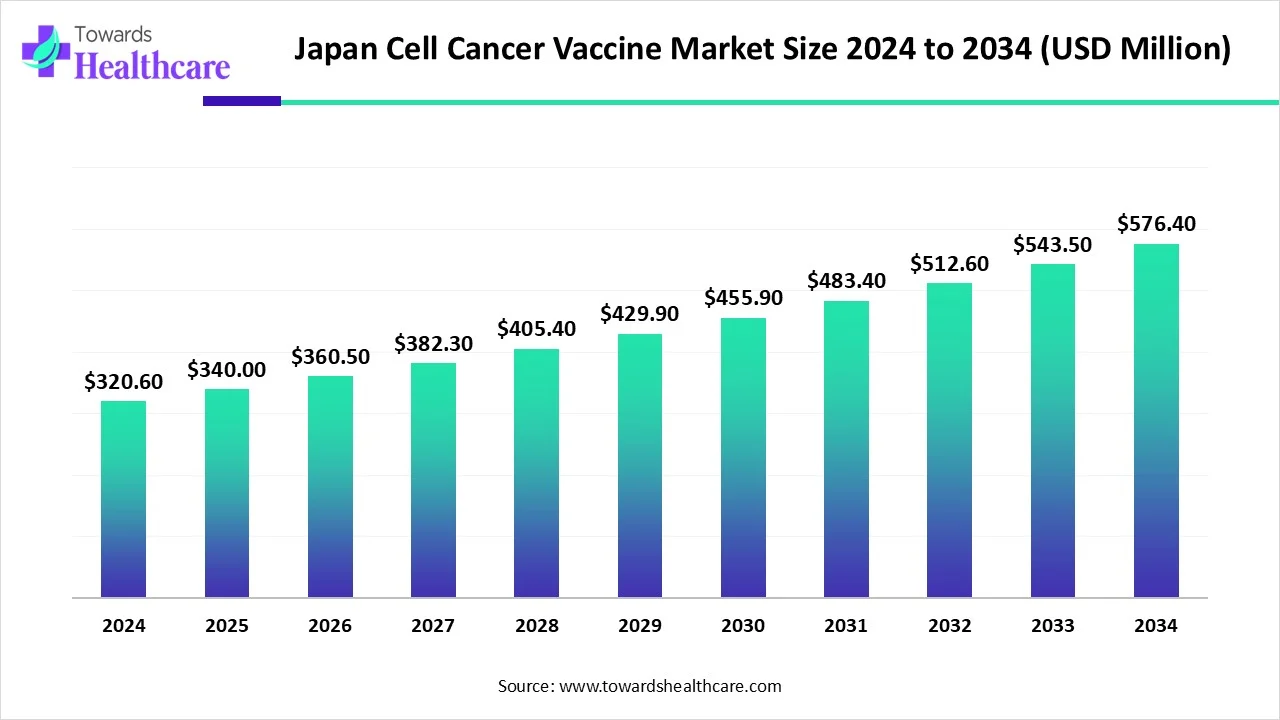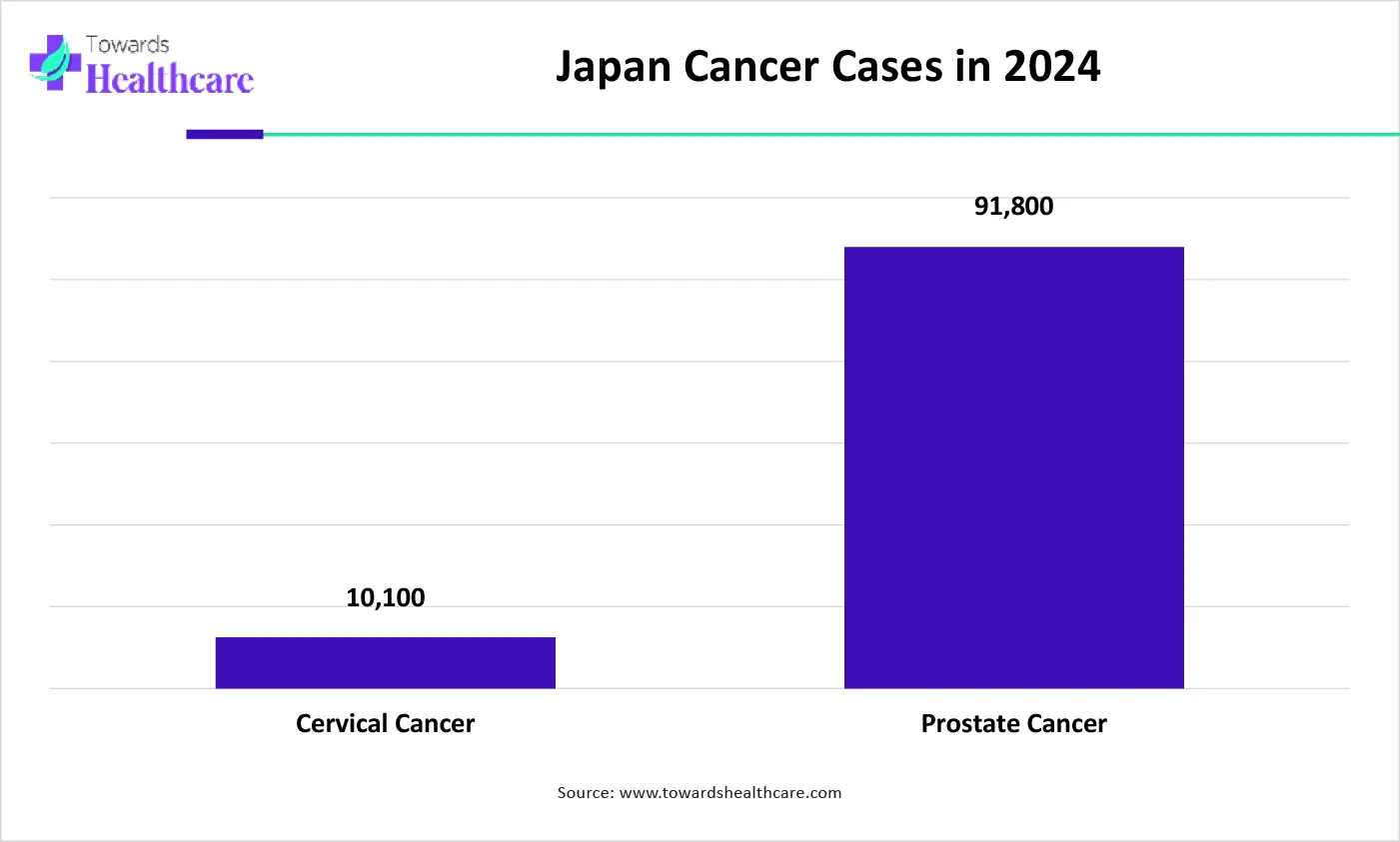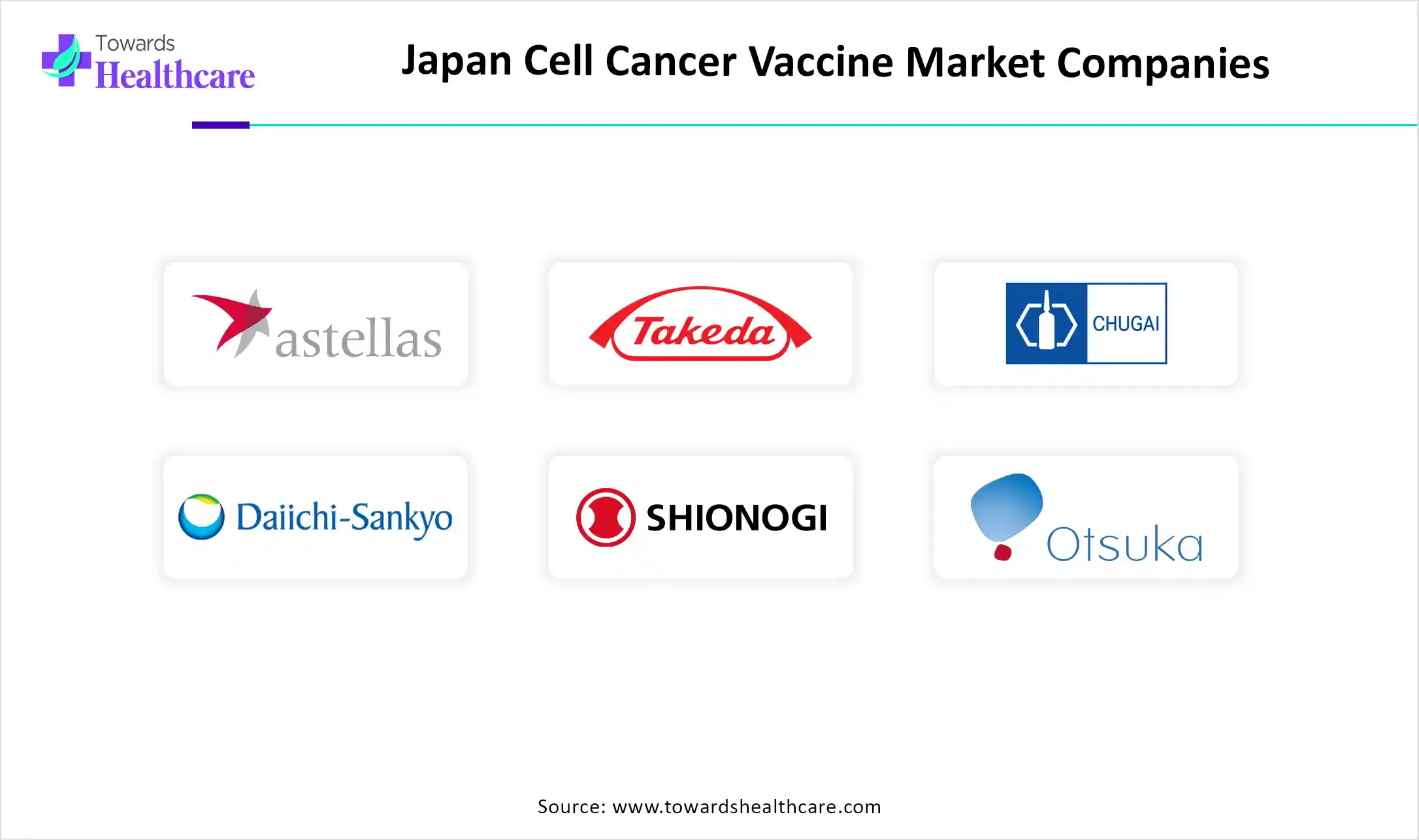December 2025

The Japan cell cancer vaccine market size is calculated at US$ 320.6 in 2024, grew to US$ 340 million in 2025, and is projected to reach around US$ 576.4 million by 2034. The market is expanding at a CAGR of 6.04% between 2025 and 2034.
There is a rise in the demand for the use of cell cancer vaccines in the treatment of different types of cancer in Japan. At the same time, new developments are also being conducted along with the use of AI. This, in turn, is leading to new collaborations as well as launches. Furthermore, the growing use of therapeutic and vector-based vaccines is also driving their use. Additionally, their target action and reduced toxicity are increasing their acceptance rates, improving patient outcomes. Thus, all these growing developments are promoting the Japan cell cancer vaccine market growth.

To stimulate an adaptive immune response as well as to imitate the natural immune process to fight against tumor antigens, the use of autologous antigen-presenting cells, autologous patient-derived tumor cells, and allogeneic cancer cell lines is used by the cell-based cancer vaccines. These cell cancer vaccines are being preferred in the treatment of a variety of cancer types due to their significant clinical benefits. At the same time, new vaccine therapies are also being discovered. Thus, the growing use of these vaccines will continue to evolve, providing potential applications in the field of anti-cancer therapy.
To improve the design and development of cancer vaccines, the use of AI is increasing. At the same time, by anticipating the patient responses, the AI helps in enhancing the optimization of personalized vaccine strategies, epitope design, and mRNA and DNA vaccine instructions. Moreover, the efficacy and precision of the cancer vaccines are also improved as they help to discover new therapeutic targets and interpretations of complex biological datasets. Additionally, its use in the development of personalized cancer vaccines and immunotherapies is also increasing, enhancing cancer vaccine development.
Rising Incidence of Cancer
The rising incidence of cancer in Japan is increasing the demand for the use of cancer cell vaccines. As the use of traditional treatments is often associated with side effects, the use of these vaccines is growing. Thus, the use of these vaccines stimulates the immune system of the body, showing reduced toxic effects of the treatment. At the same time, the use of personalized treatment approaches is also enhancing their use. Therefore, the use of cell cancer vaccines is providing targeted action, enhancing the patient outcome. Thus, this promotes the Japan cell cancer vaccine market growth.

The graph represents the total number of cancer cases reported in Japan in year of 2024. It indicates that there will be a rise in cases of cancer. Hence, it increases the demand for cell cancer vaccines for their effective management. Thus, this in turn will ultimately promote the market growth.
High Price
The cell cancer vaccines are costly, which in turn, limits their adoption by patients. At the same time, the lack of infrastructure also makes their production expensive, adding to the cost. As well as the regulatory procedures also contribute to their enhanced cost. Additionally, the delay in the reimbursement also reduces their use. Thus, the high prices of the cancer vaccines may restrain the market growth.
Why is the Growing Use of Peptide-Based Cancer Vaccines an Opportunity in the Japan Cell Cancer Vaccine Market?
The growing cancer cases is increasing the demand for cancer vaccines. At the same time, rising developments in the peptide-based cancer vaccines are also attracting patient, promoting their use. These vaccines stimulate the T-cells, enhancing the immune responses. Moreover, its use in the early stages of cancer is increasing due to its affordability. Thus, their use in the treatment of different types of cancer is increasing. Additionally, new developments to enhance the action, as well as to develop new combination approaches, are also increasing. Thus, its growing use is promoting the Japan cell cancer vaccine market growth.
For instance,
By vaccine type, the therapeutic cancer vaccines segment held the dominating share in the market in 2024. The use of therapeutic cancer vaccines increased due to the increased cancer cases. At the same time, the development of personalized therapeutic cancer vaccines also contributed to the same. Moreover, it was also used in combination with other therapies, enhancing the market growth.
By vaccine type, the preventive cancer vaccines segment is expected to show the fastest growth rate at a notable CAGR during the predicted time. The growing awareness of cancer is increasing the use of preventive cancer vaccines. Moreover, various vaccination campaigns are also increasing their use. Additionally, their use is also promoted by the government.
By indication type, the prostate cancer segment led the market in 2024. Due to the growing incidence of prostate cancer in the aging population in Japan, the use of prostate cancer vaccines increased. With the use of these vaccines, the immune response was enhanced, providing successful results. Thus, this in turn enhanced their use, contributing to the market growth.
By indication type, the cervical cancer segment is expected to show the highest growth during the forthcoming period. The growing awareness, as well as the vaccination campaigns for cervical cancer, is increasing the use of cell cancer vaccines. Moreover, to eliminate cervical cancer, the use of cost-effective cancer vaccines is also increasing.
By technology type, the vector-based vaccines segment held the largest share in the global market in 2024. The vector-based vaccines stimulated the T cell responses, enhancing the action, due to which their use in Japan increased. At the same time, the development of personalized vector-based vaccines increased their acceptance rate. Thus, this promoted the market growth.
By technology type, the DNA/RNA-based vaccines segment is expected to show the fastest growth rate during the upcoming years. Due to the target-specific action, the use of DNA/RNA-based vaccines is increasing. This, in turn, also enhances their development for personalized cancer vaccines. Furthermore, the growing investments from the government and private sectors are also enhancing their production and acceptance rates.
The Japan cell cancer vaccine market is expected to grow significantly during the forecast period. The growing incidence of cancer cases in Japan is increasing the demand for cancer cell vaccines. At the same time, due to these rising cancer cases, the interest in the development of new cell-based cancer vaccines is also increasing. This, in turn, increases the development of personalized cancer vaccines. As these vaccines show reduced toxicity and side effects, their acceptance rate also increases. Additionally, the presence of advanced technologies is also driving their production as well as innovations. Moreover, the growing development is also supported by the government as well as the private sector. Thus, all these factors promote the market growth.

By Vaccine Type
By Indication
By Technology
December 2025
December 2025
December 2025
December 2025